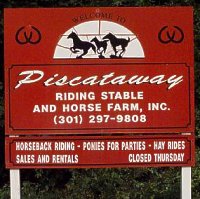
ASGRA sponsored trail rides are scheduled on the first Sunday of each month all year long. In case of rain, snow or ice, we will reschedule the ride for the second Sunday of the month.
If you are interested in attending, RSVP (let us know) by calling or texting Patrick at 202-352-2356 before 9:00 am on Sunday.
Please Note: Trail Rides are limited to 20 riders. If you do not RSVP to Patrick at 202-352-2356, we will not be able to guarantee a horse for you.
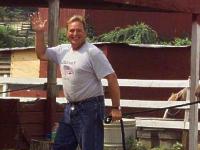
Rides begin at Piscataway Stables, in Piscataway, Md. (which is just south of Clinton, Md.)
Directions
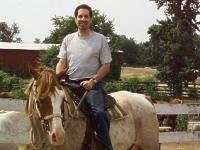 Take the Washington Beltway to Maryland exit 7, Branch Ave. South.
Take the Washington Beltway to Maryland exit 7, Branch Ave. South.
Go 3 1/2 miles, exit right onto Maryland route 223 toward Clinton.
Proceed another 3 1/2 miles, to Piscatway stables on the right, just past the small airport. Click for a map
Cost is $40 for ASGRA trailriders ($45 for others). They've got lots of horses and you can pretty much specify what you want, and they'll find an animal that meets your criteria, whether you're a highly experienced rider or have never so much as been on a horse before.
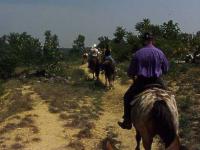
Please arrive by 10 a.m. to complete needed paperwork for the trail ride, and pay if you have not paid beforehand. Your horse will be selected for you based on your experience, and before we ride we will go over some riding basics.
A few suggestions for riding apparel...

Cowboy boots if you have them. If you don't have boots, try to wear a hard toed shoe with a heel. Work boots are a good choice. You need to be able to slip out of the stirrup quickly in case of an emergency, so a leather sole is better than a rubber sole. Sneakers or open toed shoes are not a good idea. A leather or steel toe work boot can help protect the foot if it's stepped on by a hoof.
Wear clothes you don't mind getting dirty, muddy or possibly torn. Tearing is rare but it can happen.
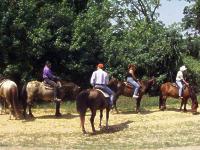
LONG pants are important, denim jeans are perfect. If you don't have jeans you can mess up, try to select a tough material that will protect your legs from chafing against the tack (saddle), or getting scratched by brush, thorns, tree trunks, insects, poison ivy, or falls.
A hat is a very good idea. If you have one, a cowboy hat is perfect. The old time cowboys really did know how to dress properly, and everything they wore had a purpose. The wide brim of the cowboy hat, helps keep the sun off your face and it makes one of the best rain hats around. If you don't have a cowboy hat, a baseball cap will work well to keep the sun out of your eyes.
In winter, layered clothing, such as long underwear will be a welcome addition on a cold ride.
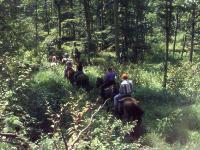
Gloves are good in both seasons, but essential in cold weather. Work or rough leather gloves are fine.
If you are the brave dedicated type and show up on a rainy day, the ride will go on, but you should bring a slicker, rain coat, or weatherproof duster, and rain hat. Again a cowboy hat with or without a rain cover makes an excellent rain hat.

Cameras? Certainly, bring a small pocket size camera. Avoid large 35 mm cameras with big lenses, you are going to have enough to concentrate on without worrying about dropping an expensive camera. If this is your first ride, you might consider asking a more experienced rider to carry your camera as you will probably be concentrating on learning how to communicate with your horse. Then too, they can take your picture so you can show your friends that you really are becoming a cowboy or cowgirl.





















